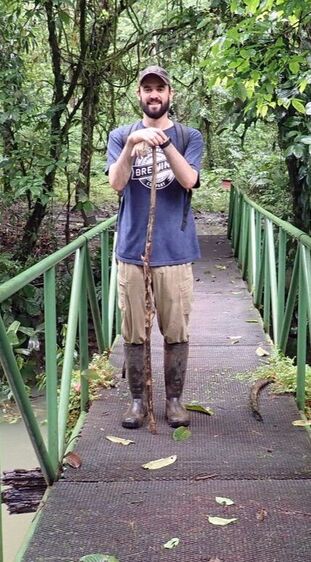
My interests lie in the water: who lives in it, what is in it, how much of it is there, is that amount the same as was previously? My background in biology leads me to questions relating to who is in the water, but also as an ecologist, how does life in the water respond to the conditions out of their control.
As a third generation aquatic ecologist, my upbringing influenced my career choice. Many a weekend was spent on the waters of Central Florida: on canoe, on a boat, fishing, going to the ponds in the neighborhood, and tagging along on airboat rides through the lakes in the region. This early immersion (unintentional on my part) resulted in science coming naturally in school, and to complete a BS in Biology from the University of Florida. I worked as a technician for an ecotoxicology lab as an undergraduate, identifying algae, picking bug samples, and running effluent tests.
I received my MS in Ecology from the University of Georgia and the Jones Ecological Research Center in southwest Georgia in 2015. My research documented the invasion of the apple snail, P. maculata, in Lake Seminole, a large reservoir in the Apalachicola-Chattahoochee-Flint (ACF) basin on the Florida-Georgia border. Our findings show invasive P. maculata are spreading throughout the lake, at an increasing rate and increases were concurrent with decreases in the native P. paludosa. We examined possible limitations to continued expansion of the snails in the region based on its physiological tolerances, and discovered combined low temperature and reduced calcium concentrations negatively affected growth and survival.
I received my Ph.D. in the Department of Forestry and Environmental Resources at North Carolina State University. My research, advised by Dr. Marcelo Ardón, took place at La Selva Biological Station, Costa Rica as part of the STREAMS project. My research focused on disentangling CO2 fluxes in a headwater stream, merging high-frequency sensor data, ecosystem modeling, and groundwater influences. I expanded on this to study the acidic effects of groundwater CO2 inputs on a hierarchy of stream function, including biological growth rates to rates of organic matter decomposition.
As a third generation aquatic ecologist, my upbringing influenced my career choice. Many a weekend was spent on the waters of Central Florida: on canoe, on a boat, fishing, going to the ponds in the neighborhood, and tagging along on airboat rides through the lakes in the region. This early immersion (unintentional on my part) resulted in science coming naturally in school, and to complete a BS in Biology from the University of Florida. I worked as a technician for an ecotoxicology lab as an undergraduate, identifying algae, picking bug samples, and running effluent tests.
I received my MS in Ecology from the University of Georgia and the Jones Ecological Research Center in southwest Georgia in 2015. My research documented the invasion of the apple snail, P. maculata, in Lake Seminole, a large reservoir in the Apalachicola-Chattahoochee-Flint (ACF) basin on the Florida-Georgia border. Our findings show invasive P. maculata are spreading throughout the lake, at an increasing rate and increases were concurrent with decreases in the native P. paludosa. We examined possible limitations to continued expansion of the snails in the region based on its physiological tolerances, and discovered combined low temperature and reduced calcium concentrations negatively affected growth and survival.
I received my Ph.D. in the Department of Forestry and Environmental Resources at North Carolina State University. My research, advised by Dr. Marcelo Ardón, took place at La Selva Biological Station, Costa Rica as part of the STREAMS project. My research focused on disentangling CO2 fluxes in a headwater stream, merging high-frequency sensor data, ecosystem modeling, and groundwater influences. I expanded on this to study the acidic effects of groundwater CO2 inputs on a hierarchy of stream function, including biological growth rates to rates of organic matter decomposition.
After my Ph.D., I served as a postdoctoral scholar at NCSU to examine long-term spatial and temporal variation in streams at La Selva, aiming to distinguish temporal effects of short term seasonality and long-term effects of climate variation against landscape effects of groundwater inputs to lowland streams.
In 2022, I moved to Duke University as Postdoctoral Associate on the StreamPulse & Macrosheds project, work on urban streams in North Carolina, and integrating ecosystem metrics towards stream consumers.
In 2022, I moved to Duke University as Postdoctoral Associate on the StreamPulse & Macrosheds project, work on urban streams in North Carolina, and integrating ecosystem metrics towards stream consumers.

